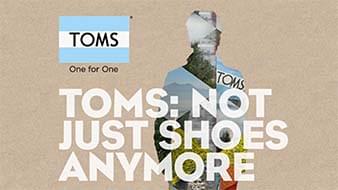
With an ever-changing social climate, it’s no surprise that media messaging has evolved with the times. From catchy jingles and fluff to social commentary, there’s been a noteworthy shift in overall strategy. And this doesn’t exclude marketing and advertising. In the early 2000s, we saw an increase in cause-driven campaigns, and it’s only become more prominent since then. But how did we get here?
Old school efforts
Marketing used to be all about the product. Take a look at personal care brands like Dove. Their early ads were centered on the benefit of using Dove Beauty Bars. Creamy and soft soap meant clean and smooth skin. And, who could ask for more? When it came to the market, all competitors had the same messaging: “Here’s what our product can do for you.”

But come 2004, everything changed. Dove launched their first “Real Beauty” campaign after a survey stated that less than 2% of women thought of themselves as beautiful.1 In years to come, Dove’s commercials transformed from emphasizing vanilla-scented body wash to addressing various real-world issues — like self-esteem, unattainable beauty standards, and body image issues.

They haven’t turned away from cause-driven marketing since.
In turn, this humanized their brand. A notable example is their 2021 “Reverse Selfie” advertisement. It focused on the role editing apps can play in younger girls’ self-esteem — and it urged parents to have open discussions with their children about it. The campaign garnered numerous positive comments. Some adults admitted they wished ads like this existed when they were younger or they were touched that Dove even spoke out.
Being willing to take a step back from pushing products and placing focus on consumers’ issues set them up for great success.
The shift to social issues
Although examples of cause-driven marketing date back to the 1980s, we’ve really seen it rise in the last two decades.
Each brand takes their own approach. There are some — like TOMS, Warby Parker, and TWICE — that take the “buy something, give something” approach. Whereas other businesses use strategic messaging or evocative creative. No matter the method, it’s a way for brands to align themselves with customers’ values. And voicing those opinions helps to create not only brand awareness, but also customer loyalty.

Cause-driven advertising has become so prominent that brands are now expected to state their opinions on social issues. And for good reason. Over 60% of consumers are belief-driven buyers, and those buyers make up the majority in every market surveyed — across all age ranges and income levels.2
Winners and write-offs
We can’t talk about this strategy without acknowledging the pivotal campaign that is Nike’s Colin Kaepernick collaboration. In the words of MKR Chief Creative Officer Peter Kim, “It’s probably the very best case study of cause-driven marketing in the modern era. The campaign went so far as to champion not only the talent, but the beliefs that Kaepernick held dear.” The use of strong shared beliefs in their advertisements led to a 10% company income increase and a 7% jump in stock prices. This is a stance the public is proud to take, and the proof is in the numbers. But what really makes this campaign a success? Nike believes in and supports the movement behind the campaign.

However, not every advertisement can be a winner. In regards to social-driven flops, Pepsi is one of the first examples that comes to mind. The notorious “Live For Now” commercial starring Kendall Jenner received well-deserved criticism — saying it trivialized the Black Lives Matter movement and the reality of police brutality. Pepsi responded by pulling the campaign from the air and apologizing to the masses. But they aren’t the only ones.
Peter stumbled upon an even more recent example. “I saw an ad that popped up in my social feed — it’s for a popular sneaker brand,” said Peter. “The ad shows a shoe photographed against a backdrop of graffiti with the headline, ‘Human Rights Now!’ and a subhead that reads, ‘Classic leather.’” It’s ads like these that leave consumers angry, confused, and put off by your brand. To Peter, this creative read as dishonest and opportunistic.
No turning back
Whether successful or not, cause-driven marketing isn’t going anywhere. So it’s crucial to know the ins and outs of the practice.
Effective strategizing starts with understanding your brand values and your audience’s beliefs. Find the overlap. If there is a social issue that your brand and your consumers genuinely care about that aligns with your findings, consider developing a campaign.
If it’s successful, not only does your brand raise awareness for an important issue, but in turn your consumers feel heard and valued — building trust and loyalty.
But, tread with caution. Don’t create socially driven creative that’s lazy, opportunistic, or performative. Not every issue will fit with your brand. So don’t force it.
Peter said, “The biggest con is also the biggest risk, which is that your brand will come across as less than genuine.” When considering cause-driven media, ask “What’s the motivation behind this decision?” If it’s just to share your two cents, that’s not enough — and it’s not appropriate. The cause needs to be something that not only makes sense for your brand to speak on, but something you sincerely want to advocate for.
So before you jump headfirst into societal issues, pause. Consider if this decision is both appropriate and authentic. Then you can head to the drawing board.
Considering developing some belief-centered marketing but aren’t sure if it’s the right fit? MKR would love to help you figure that out.
Sources
1 The Inquisitive Mind
2 American Marketing Association
Images in Order of Appearance
1 University of Oregon. Vintage Dove Advertisement. blogs.uoregon.edu. March 13, 2023.
2 University of Oregon. Real Beauty Poster. blogs.uoregon.edu. March 13, 2023.
3 AVADA. TOMS Footwear Ad. February 2023. blog.avada.io. March 13, 2023.
4 ABC News. Colin Kaepernick Nike Ad. December 2018. abcnews.go.com. March 13, 2023.

